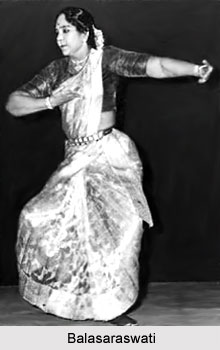 Tanjore Balasaraswati, also known as Balasaraswati was a renowned Indian dancer who left an indelible mark on the world of Bharatanatyam, a classical dance style originating from Tamil Nadu. Born on May 13, 1918, she rose to prominence through her exceptional talent and dedication to the art form. Recognized globally for her captivating performances, Balasaraswati received numerous accolades and honors throughout her illustrious career.
Tanjore Balasaraswati, also known as Balasaraswati was a renowned Indian dancer who left an indelible mark on the world of Bharatanatyam, a classical dance style originating from Tamil Nadu. Born on May 13, 1918, she rose to prominence through her exceptional talent and dedication to the art form. Recognized globally for her captivating performances, Balasaraswati received numerous accolades and honors throughout her illustrious career.
Early life of Balasaraswati
Hailing from a matrilineal family deeply rooted in the traditions of dance and music, Balasaraswati was the seventh-generation representative of her lineage. Her ancestry can be traced back to Papammal, a celebrated dancer and musician who enjoyed patronage from the court of Thanjavur during the mid-eighteenth century. Her grandmother, Vina Dhanammal, held great influence as a musician in the early twentieth century, while her mother, Jayammal, was a talented singer who played a pivotal role in nurturing Balasaraswati`s passion for dance and music.
Balasaraswati`s introduction to music came at an early age, as she received comprehensive training within her family from infancy. Her formal training in dance commenced at the tender age of four, under the tutelage of the esteemed dance teacher K. Kandappan Pillai, a member of the renowned Thanjavur Nattuvanar family. Balasaraswati`s younger brothers, T. Ranganathan and T. Viswanathan, also became notable musicians in India and even showcased their talent in the United States.
Career of Balasaraswati
Balasaraswati`s dancing career began in 1925, and she made history as the first performer of her traditional style to showcase her artistry outside of South India. Her debut outside the region took place in Kolkata (former Calcutta) in 1934, captivating audiences with her unparalleled talent. Choreographer Uday Shankar, enthralled by her performances, became an ardent advocate for Balasaraswati`s art. Throughout the 1930s, she gained widespread acclaim across India, capturing the hearts of audiences everywhere. Esteemed dancers such as Shambhu Maharaj, Dame Margot Fonteyn, Martha Graham, and Merce Cunningham expressed admiration for her extraordinary skills.
In the 1950s, interest in Bharatanatyam experienced a resurgence, with Balasaraswati at the forefront of promoting this unique Indian art form. Encouraged by an administrator at the Music Academy in Madras, she established a dance school affiliated with the institution. This initiative allowed her to impart her vision and train a new generation of Bharatnatyam dancers. In the early 1960s, Balasaraswati embarked on international tours, enchanting audiences in East Asia, Europe, and North America. From the late 1960s to the early 1980s, she made multiple visits to the United States, conducting residencies as both a teacher and a performer at esteemed institutions such as Wesleyan University, California Institute of the Arts, Mills College, the University of Washington, and Jacob`s Pillow Dance Festival. Her efforts not only exposed diverse audiences to the traditional style of Bharatanatyam but also trained numerous new practitioners of this art form.
Recognitions of Balasaraswati
Balasaraswati`s remarkable contributions to dance garnered widespread recognition and prestigious awards. In 1955, she received the President`s Award from the Sangeet Natak Akademi, an esteemed institution promoting Indian music, dance, and theater. In 1973, she was honored with the Sangita Kalanidhi from the Madras Music Academy, the highest accolade for musicians in South India. The Government of India recognized her immense talent and dedicated service by bestowing upon her the Padma Vibhushan, the second-highest civilian honor, in 1977. Her impact reached far beyond India`s borders, as evidenced by her inclusion as the only non-western dancer in the Dance Heritage Coalition`s compilation, "America`s Irreplaceable Dance Treasures: The First 100" in 2000.
Death of Balasaraswati
Tragically, Balasaraswati`s exceptional journey came to an end on September 9, 1984. However, her legacy continues to resonate within the realms of dance and music. Her contributions have left an indelible mark, revolutionizing the traditional arts and introducing Bharatanatyam to audiences worldwide. Through her international engagements and dedicated teaching efforts, Balasaraswati not only showcased the beauty and depth of this ancient dance form but also ensured its preservation for future generations.
Legacy of Balasaraswati
Balasaraswati"s daughter, Lakshmi Knight, achieved distinction as a performer in her mother`s style. Continuing the family legacy, Balasaraswati`s grandson, Aniruddha Knight, presently serves as the artistic director of the Bala Music and Dance Association in the United States and the Balasaraswati School of Dance in India. Notably, her son-in-law, Douglas M. Knight, Jr., authored her biography with the support of a Guggenheim Fellowship in 2003. Furthermore, acclaimed Indian filmmaker Satyajit Ray created a documentary highlighting Balasaraswati`s remarkable contributions to the arts.
Tanjore Balasaraswati`s life and career exemplify the transformative power of dance and the profound impact that a single artist can have on an art form. Her unwavering dedication, artistic brilliance, and global recognition have immortalized her as a legendary figure in the world of Bharatanatyam, securing her a revered place in the pantheon of classical Indian dancers. As her legacy lives on, her contributions will continue to inspire and captivate generations to come, preserving the rich cultural heritage of India`s traditional performing arts.




